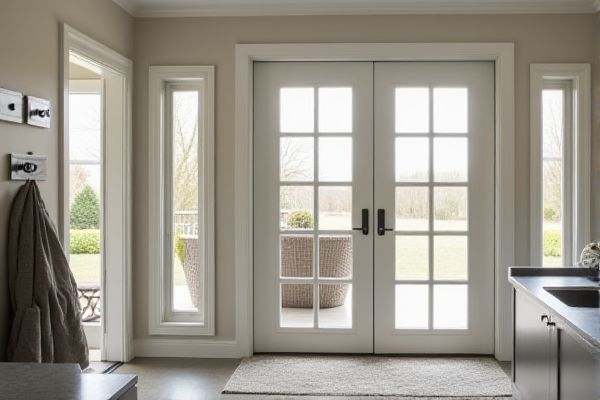
Mudroom swing doors offer easy access and a classic look, ideal for high-traffic areas where you need durability and straightforward operation, while bifold doors save space by folding neatly to the side, making them perfect for smaller mudrooms or tight spaces. Explore the rest of the article to discover which option best suits your mudroom's design and functionality needs.
Table of Comparison
| Feature | Mudroom Swing Door | Bifold Door |
|---|---|---|
| Space Efficiency | Requires clear space to swing open | Folds to the side, saving floor space |
| Installation | Simple to install, standard hinges | Complex installation with tracks and hinges |
| Durability | Sturdy, fewer moving parts | Multiple hinges prone to wear |
| Accessibility | Full doorway access | Partial doorway access when open |
| Maintenance | Low maintenance | Requires regular upkeep of tracks and hinges |
| Cost | Generally lower cost | Typically more expensive |
| Usage | Ideal for high-traffic mudrooms | Suitable for compact spaces |
Introduction to Mudroom Entry Options
Mudroom entry options include swing doors and bifold doors, each offering distinct benefits for space management and accessibility. Swing doors provide a traditional, sturdy entry method with wide clearance, while bifold doors maximize space efficiency by folding compactly against the wall. Your choice depends on the layout of your mudroom and the amount of space available for door operation.
What Is a Mudroom Swing Door?
A mudroom swing door is a traditional hinged door that swings open and closed, providing easy access and durability for high-traffic areas like mudrooms. Unlike bifold doors, which fold in sections to save space, a swing door offers a solid barrier that can help contain dirt and moisture from entering your home. Choosing a mudroom swing door supports functionality and a classic aesthetic in your entryway design.
What Is a Mudroom Bifold Door?
A mudroom bifold door consists of two hinged panels that fold together to open, maximizing space in compact entryways. This type of door offers easy access while maintaining a sleek and organized appearance, ideal for tight mudroom layouts. Compared to swing doors, bifold doors reduce clearance needs, optimizing functionality without sacrificing style.
Space Efficiency: Swing Doors vs. Bifold Doors
Swing doors require clear space to open fully, making them less ideal for small mudrooms where every inch counts. Bifold doors fold neatly against the wall, maximizing usable floor space and offering better space efficiency in compact areas. Your choice depends on whether you prioritize unobstructed access or saving room for other activities.
Aesthetic Appeal and Design Flexibility
Mudroom swing doors offer a classic, clean look with solid panels that easily complement traditional and farmhouse styles, enhancing the space's warmth and inviting atmosphere. Bifold doors provide superior design flexibility by folding neatly to maximize entry space and can incorporate glass or slatted panels, allowing natural light to flow while maintaining privacy. Choosing between these options depends on the desired aesthetic impact and the functional need for space optimization in the mudroom layout.
Ease of Access and Functionality
A mudroom swing door offers straightforward ease of access with a single, full-opening panel that allows for quick entry and exit, ideal for carrying items like shoes or coats. Bifold doors maximize functionality by folding neatly to the side, saving space and providing wider access without encroaching on adjacent areas. While swing doors tend to be more durable and secure, bifold doors enhance room efficiency, especially in compact mudroom layouts.
Durability and Maintenance Considerations
Mudroom swing doors offer robust durability with simpler hardware, making them easier to maintain and less prone to mechanical failure over time. Bifold doors, while space-saving, require regular lubrication and alignment checks due to multiple hinges and tracks, increasing maintenance needs. You'll find that swing doors provide a more long-lasting and low-maintenance solution for high-traffic mudroom areas.
Cost Comparison: Swing Doors vs. Bifold Doors
Swing doors for mudrooms generally cost more due to their sturdy construction and custom hardware requirements, typically ranging from $300 to $700 per door. Bifold doors are often less expensive, averaging between $150 and $400, as their design uses lighter materials and simpler mechanisms. Your choice impacts both initial expenses and long-term durability, with swing doors offering greater longevity at a higher upfront cost compared to the budget-friendly bifold options.
Best Use Cases for Each Door Type
Mudroom swing doors are ideal for tight spaces where simplicity and easy access are key, offering a complete seal against dirt and moisture, making them perfect for areas with heavy outdoor traffic. Bifold doors are best suited for wider openings where space-saving is essential, allowing maximum access without requiring room for door swing, commonly used in mudrooms with limited floor space or connected to closets or laundry areas. Choosing between the two depends on the specific layout constraints and accessibility needs of the mudroom environment.
How to Choose the Right Door for Your Mudroom
Choosing the right door for your mudroom depends on space efficiency, ease of access, and aesthetic preferences. Swing doors provide a traditional look with full access but require ample clearance, while bifold doors save space by folding compactly, ideal for narrow or crowded mudrooms. Consider traffic flow and storage needs to select a door that complements your mudroom's functionality and design.
 homyna.com
homyna.com